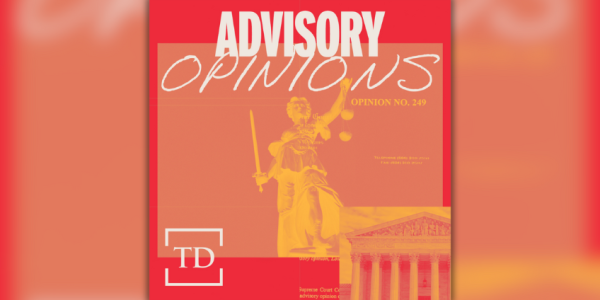Writing about the Supreme Court necessitates using terms that are familiar mostly to lawyers and those who follow the court closely. We’re providing this glossary as a resource.
OT19 (pronounced “O-T-Nineteen”): This stands for October Term 19, which is how lawyers and judges refer to a given year at the court. It’s the same idea as referring to a fiscal year in accounting. And for those West Wing fans, the court starts the term on the first Monday in October—the Red Mass is held on the Sunday immediately preceding it.
Cert (pronounced “sert” like the second syllable of assert): This is shorthand for certiorari, which is too annoying to pronounce in its entirety for most lawyers and even the justices can’t agree on how to say it. It is Middle English from Latin for “to be informed of.” The Supreme Court has almost complete discretion over which cases it chooses to hear (except cases over which it has original jurisdiction like interstate water disputes or in the rare instance in which Congress has created a direct appeal like redistricting). After a case is decided by a lower appellate court, a party can ask for the Supreme Court to review the decision with a petition for a writ of certiorari. (Technically, the court can take a case before that—called certiorari before judgment—as it did in the census case in 2019.)
The Supreme Court receives about 7,000 of these per year and hears about 75 cases a term (go back just a few decades and that number was double). It takes four justices to agree to take a case, which generally means that any case the court decides to hear has at least four justices who would consider overturning the lower court’s decision—and in fact about two-thirds of the time that’s what they do.
What happens to the other 6,925 denied petitions? The circuit court decision stands.
Non-argument sessions: On the Supreme Court’s calendar, the remaining Mondays in May and June are marked in blue as non-argument sessions, which means the court may hand down opinions on those days at 10 a.m. Under normal circumstances, the justices do this from the bench and read summaries of the opinions. Most of the time, dissenting justices don’t read summaries of their dissents, but there are plenty of exceptions. During the pandemic, the opinions have simply appeared on court’ website on these designated days, which have also been labeled “opinion issuance days” on the May calendar to signify that the justices are not convening in the courtroom. As we head into June, the chief justice often announces additional opinion hand-down days—typically Thursdays when the justices have their conferences to vote on cert petitions.
Consolidated cases: It’s not uncommon for several cases with the same legal issues to work their way through the lower court system around the same time. The Supreme Court many times will grant cert to two or more of these similarly situated cases and they will hear arguments for them at the same time. Sometimes the consolidated parties may split their argument time with the court’s permission; sometimes not. The consolidated cases are not merged and may not have the same outcome. (See, e.g., the ministerial exception cases.) The court may also hear similar cases on the same day with separate arguments without consolidating them. (See, e.g., the Trump finance cases.)
CVSG: This one is actually in english. It’s just an acronym that is used when the court “calls for the views of the solicitor general” on any given case—the court is considering whether to grant cert on a question in which the federal government has some underlying interest.
Request for divided argument: Each party arguing before the court usually gets 30 minutes to state their case and answer questions. An amicus curiae can ask to take some of the argument time—usually 10 minutes—with the permission of the court and the side whose time they are asking to take. These requests are almost always denied by the court with one big exception. The solicitor general’s request for argument time is almost always granted. And sometimes, when the SG isn’t squarely on one side or the other, the SG’s office may request to increase the overall argument time so that its 10 minutes don’t come out of either party’s allotted 30 minutes.
Circuit split: A case is more likely to be granted cert (ie heard by the Supreme Court) if the cert petition can show that two or more circuit courts (the country is divided into 12 circuits plus some speciality courts like the federal circuit which hears things like patent cases) that have considered the same legal questions have come to opposing conclusions, meaning that different parts of the country are operating under contradictory legal holdings.
Supreme Court Bingo: The Supreme Court hears roughly nine cases each month that it sits. Because there are nine justices and they try to distribute their workload evenly, generally each justice will write the majority opinion for one of those nine cases in a given month of argument. So throughout the term as opinions are released and the authoring justice is identified, you can start to predict with increased accuracy who will be writing the opinions for the outstanding cases. For example, the only remaining case from the November sitting is the DACA case and the only justice who hasn’t written a majority opinion from the November sitting is Chief Justice Roberts. In some cases, this allows avid court followers to make predictions on the outcome of cases based on whether justices with well-known jurisprudential philosophies on an issue are presumed to be writing the opinion. Why bingo? Because SCOTUSblog started making this handy chart, and at least in my house, we call it the bingo card.
Concurring in the judgment: Concurring means that a justice agrees with the majority’s opinion in full but has some additional thoughts to add. Dissenting means the justice disagrees with the outcome of the majority’s opinion. Concurring in part and dissenting in part is exactly what it sounds like—in a case with multiple issues, a justice agrees with the majority on some and disagrees on others. Concurring in the judgement, however, means that a justice agrees with the outcome of the case but not with the majority’s reasoning. There is an interesting—and still unresolved—question as to which opinion sets the precedent of the court in a 4-1-4 case in which the fifth justice only concurs in the judgment.
Per curiam (pronounced “purr cure-ee-yum”): More Latin! This means “by the court” and refers to an opinion that does not say which judge authored it. These opinions—often referred to in shorthand as “PC opinions” are often unanimous and issued when the court is deciding a case without oral argument, but it’s not unheard of to see a dissent from time to time, which is signed by a justice(s). Usually, these opinions don’t include new legal interpretations and/or are confined to the specific facts of the case being decided. But there are some major exceptions like Bush v. Gore (2000 election), Buckley v. Valeo (campaign finance), Ex Parte Quirin (WWII saboteurs), Brandenburg v. Ohio (free speech), New York Times Co v. United States (Pentagon Papers)—all PC opinions.
DIG (pronounced like the action you take with a shovel): This stands for “dismissed as improvidently granted” and is most often used when the justices learn something about the case after it has been granted that makes it a poor vehicle for deciding the legal question at issue. Although the court has never officially said how many justices are required to vote to DIG a case, it would make sense that at least six would be necessary in order to include at least one of the four justices that voted to grant cert in the first place. However, there are examples—including in 2010 and 2013—in which four justices dissented from a five-justice DIG. When a case is DIG’d, the case is treated as if the court had never granted cert in the first place.
“The judgment is affirmed by an equally divided court”: This happens if a justice recuses from a case and the resulting vote was 4-4. It doesn’t include legal analysis or which way each justice voted. This means that the ruling of the circuit court—either from the three judge panel or the en banc court—below stands. It doesn’t set any precedent. It’s just status quo ante.
En banc (pronounced ‘on bonk’): We’re learning French this time and it means “on the bench.” At the circuit court level, a panel of three judges are assigned to decide a case. But after the panel issues its decision, the circuit may decide to hear the case en banc, meaning that a majority of the judges on that court vote to undo the panel’s decision (maybe it conflicts with another panel that heard a similar case or maybe those 3 judges just annoyed their colleagues). In all but one circuit, this means that all the active judges hear the case sitting at one long bench. (The 9th Circuit has 29 judges and uses 11 judges to hear a case en banc.)








Please note that we at The Dispatch hold ourselves, our work, and our commenters to a higher standard than other places on the internet. We welcome comments that foster genuine debate or discussion—including comments critical of us or our work—but responses that include ad hominem attacks on fellow Dispatch members or are intended to stoke fear and anger may be moderated.
You are currently using a limited time guest pass and do not have access to commenting. Consider subscribing to join the conversation.
With your membership, you only have the ability to comment on The Morning Dispatch articles. Consider upgrading to join the conversation everywhere.